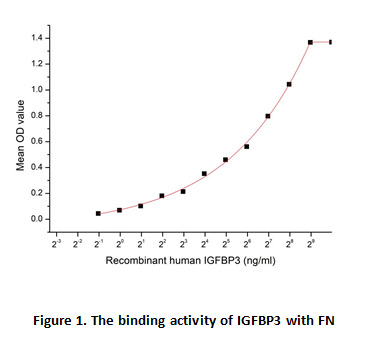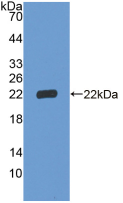Active Insulin Like Growth Factor Binding Protein 3 (IGFBP3)
BP53; IBP3; Growth Hormone-Dependent Binding Protein; Acid Stable Subunit Of The 140 K IGF Complex
- Product No.APA054Hu01
- Organism SpeciesHomo sapiens (Human) Same name, Different species.
- Buffer Formulation100mMNaHCO3, 500mMNaCl, pH8.3, containing 0.01% SKL, 5% Trehalose.
- Traits Freeze-dried powder
- Purity> 95%
- Isoelectric Point9.3
- ApplicationsCell culture; Activity Assays.
- DownloadInstruction Manual
- UOM 10µg50µg 200µg 1mg 5mg
- FOB
US$ 211
US$ 528
US$ 1056
US$ 3168
US$ 7920
For more details, please contact local distributors!
ACTIVITY TEST

Insulin-like growth factor-binding protein 3, also known as IGFBP3 is one of six IGF binding proteins (IGFBP1 to IGFBP6) that have highly conserved structures and bind the insulin-like growth factors IGF-1 and IGF-2 with high affinity. Within tissues, IGFBP3 can bind IGF1 and IGF2 released by many cell types, and block their access to the IGF-1 receptor (IGF1R), which is activated by both IGFs. IGFBP3 also interacts with cell-surface proteins, affecting cell signaling from outside the cell or after internalization, and also enters the cell nucleus where it binds to nuclear hormone receptors and other ligands. Besides, Fibronectin (FN) has been identified as an interactor of IGFBP3, thus a binding ELISA assay was conducted to detect the interaction of recombinant human IGFBP3 and recombinant human FN. Briefly, IGFBP3 were diluted serially in PBS, with 0.01% BSA (pH 7.4). Duplicate samples of 100ul were then transferred to FN-coated microtiter wells and incubated for 1h at 37℃. Wells were washed with PBST and incubated for 1h with anti-IGFBP3 pAb, then aspirated and washed 3 times. After incubation with HRP labelled secondary antibody, wells were aspirated and washed 5 times. With the addition of substrate solution , wells were incubated 15-25 minutes at 37℃. Finally, add 50µL stop solution to the wells and read at 450nm immediately. The binding activity of IGFBP3 and FN was shown in Figure 1, the EC50 was 78 ng/ml.
USAGE
Reconstitute in ddH2O to a concentration of 0.1-1.0 mg/mL. Do not vortex.
STORAGE
Avoid repeated freeze/thaw cycles. Store at 2-8°C for one month. Aliquot and store at -80°C for 12 months.
STABILITY
The thermal stability is described by the loss rate. The loss rate was determined by accelerated thermal degradation test, that is, incubate the protein at 37°C for 48h, and no obvious degradation and precipitation were observed. The loss rate is less than 5% within the expiration date under appropriate storage condition.
GIVEAWAYS
INCREMENT SERVICES
-
 BCA Protein Quantification Kit
BCA Protein Quantification Kit
-
 Molecular Mass Marker for Protein
Molecular Mass Marker for Protein
-
 Monoclonal Antibody Customized Service
Monoclonal Antibody Customized Service
-
 Polyclonal Antibody Customized Service
Polyclonal Antibody Customized Service
-
 Protein Activity Test Experiment Service
Protein Activity Test Experiment Service
-
 Electrophoretic Mobility Shift Assay (EMSA) Experiment Service
Electrophoretic Mobility Shift Assay (EMSA) Experiment Service
-
 Buffer
Buffer
-
 Lentivirus Packaging Experiment Service
Lentivirus Packaging Experiment Service
-
 Adenovirus Packaging Experiment Service
Adenovirus Packaging Experiment Service
-
 Real Time PCR Experimental Service
Real Time PCR Experimental Service
-
 Spike RBD Protein (S-RBD)
Spike RBD Protein (S-RBD)
-
 Protein G
Protein G
-
 Protein A
Protein A
| Magazine | Citations |
| Molecular Biology Reports | Characterization of the specific and sustained GH1 expression induced by rAAV2/1 in normal adult male rats PubMed: 20204528 |
| Endocrinology | Role of IGFBP-3 in the Regulation of β-Cell Mass during Obesity: Adipose Tissue/β-Cell Cross Talk Endo: source |
| Nutrition and Cancer | A Pilot Study Comparing the Effect of Flaxseed, Aromatase Inhibitor, and the Combination on Breast Tumor Biomarkers Tandfonline: Source |
| Dig Dis Sci | The Protective Effects of Exclusive Enteral Nutrition Formulas on Growth Factor Expression and the Proximal Tibial Epiphyseal Growth Plate in a TNBS-Induced IBD Rat Model PubMed: 25708898 |
| Animal. | Effects of a dietary crude fibre concentrate on growth in weaned piglets. pubmed:28318464 |
| PLoS One | Altered insulin-like growth factor-2 signaling is associated with psychopathology and cognitive deficits in patients with schizophrenia Pubmed: 32191705 |
| Int J Environ Res Public Health | Association of Salivary IGF and IGF/IGFBP-3 Molar Ratio with Cervical Vertebral Maturation Stages from Pre-Adolescent to Post-Adolescent Transition Period—A … Pubmed:35564566 |








